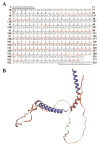The spatio-temporal expression analysis of parathyroid hormone like hormone gene provides a new insight for bone growth of the antler tip tissue in sika deer
- PMID: 38419534
- PMCID: PMC11222856
- DOI: 10.5713/ab.23.0421
The spatio-temporal expression analysis of parathyroid hormone like hormone gene provides a new insight for bone growth of the antler tip tissue in sika deer
Abstract
Objective: Parathyroid hormone like hormone (PTHLH), as an essential factor for bone growth, is involved in a variety of physiological processes. The aim of this study was to explore the role of PTHLH gene in the growth of antlers.
Methods: The coding sequence (CDS) of PTHLH gene cDNA was obtained by cloning in sika deer (Cervus nippon), and the bioinformatics was analyzed. The quantitative real-time polymerase chain reaction (qRT-PCR) was used to analyze the differences expression of PTHLH mRNA in different tissues of the antler tip at different growth periods (early period, EP; middle period, MP; late period, LP).
Results: The CDS of PTHLH gene was 534 bp in length and encoded 177 amino acids. Predictive analysis results revealed that the PTHLH protein was a hydrophilic protein without transmembrane structure, with its secondary structure consisting mainly of random coil. The PTHLH protein of sika deer had the identity of 98.31%, 96.82%, 96.05%, and 94.92% with Cervus canadensis, Bos mutus, Oryx dammah and Budorcas taxicolor, which were highly conserved among the artiodactyls. The qRT-PCR results showed that PTHLH mRNA had a unique spatio-temporal expression pattern in antlers. In the dermis, precartilage, and cartilage tissues, the expression of PTHLH mRNA was extremely significantly higher in MP than in EP, LP (p<0.01). In the mesenchyme tissue, the expression of PTHLH mRNA in MP was significantly higher than that of EP (p<0.05), but extremely significantly lower than that of LP (p<0.01). The expression of PTHLH mRNA in antler tip tissues at all growth periods had approximately the same trend, that is, from distal to basal, it was first downregulated from the dermis to the mesenchyme and then continuously up-regulated to the cartilage tissue.
Conclusion: PTHLH gene may promote the rapid growth of antler mainly through its extensive regulatory effect on the antler tip tissue.
Keywords: Antlers; Characterization; Cloning; Gene Expression; Sika Deer.
Conflict of interest statement
We certify that there is no conflict of interest with any financial organization regarding the material discussed in the manuscript.
Figures





References
Grants and funding
LinkOut - more resources
Full Text Sources
Research Materials

